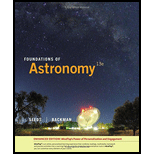
How many precession periods are in one cycle of Earth’s axis inclination variation? In one cycle of Earth’s orbit eccentricity variation? In the time span shown in Figure 2-11b, how many periods or fractions of periods did the Earth’s axis precess, nod, and Earth’s orbit change shape? Of the three periods, which is likely to have the most effect on the changes shown in Figure 2–11?
The number of precession periods in inclination change of one cycle of Earth’s axis, eccentricity variation of Earth’s orbit, and number of periods or period fractions of precision of Earth’s axis, nod, and change in shape of Earth’s orbit in time span given in figure 2.11b and also identify which one has more influence on changes plotted in figure 2.11.
Answer to Problem 14P
The number of precession periods in inclination change of one cycle of Earth’s axis is
The number of periods of eccentricity variation of Earth’s orbit is
Number of periods for a cycle of precision of Earth’s axis over time span given in 2.11b is
Number of periods for a cycle of nod over time span given in 2.11b is
Number of periods for a cycle of change in shape of Earth’s orbit in time span given in figure 2.11b is
Explanation of Solution
The precession period of Earth is around
Write the equation to find the number of precision period in a complete cycle of tilt change of Earth’s axis.
Here,
Time taken to complete one complete cycle of eccentricity variation of Earth’s orbit is almost
Write the equation to find the number of precision period in one complete cycle of eccentricity variation of Earth’s orbit.
Here,
The time span shown in figure 2.11b is
Write the equation to find number of precession periods or period fractions during
Here,
Write the equation to find number of nod periods or period fractions during
Here,
Write the equation to find number of periods for change in shape of Earth’s orbit or period fractions during
Here,
Conclusion:
Substitute
Substitute
Substitute
Substitute
Substitute
Figure 2.11 plots the temperature variation in Earth over many years. The prime important reason for seasons is the tilting of axis of Earth. So the changes in figure 2.11 is more influenced by
The number of precession periods in inclination change of one cycle of Earth’s axis is
Want to see more full solutions like this?
Chapter 2 Solutions
Foundations of Astronomy, Enhanced
- pls help on all asked questions kindlyarrow_forward19. Mount Everest, Earth's highest mountain above sea level, has a peak of 8849 m above sea level. Assume that sea level defines the height of Earth's surface. (re = 6.38 × 106 m, ME = 5.98 × 1024 kg, G = 6.67 × 10 -11 Nm²/kg²) a. Calculate the strength of Earth's gravitational field at a point at the peak of Mount Everest. b. What is the ratio of the strength of Earth's gravitational field at a point 644416m below the surface of the Earth to a point at the top of Mount Everest? C. A tourist watching the sunrise on top of Mount Everest observes a satellite orbiting Earth at an altitude 3580 km above his position. Determine the speed of the satellite.arrow_forwardpls help on allarrow_forward
- pls help on allarrow_forward6. As the distance between two charges decreases, the magnitude of the electric potential energy of the two-charge system: a) Always increases b) Always decreases c) Increases if the charges have the same sign, decreases if they have the opposite signs d) Increases if the charges have the opposite sign, decreases if they have the same sign 7. To analyze the motion of an elastic collision between two charged particles we use conservation of & a) Energy, Velocity b) Momentum, Force c) Mass, Momentum d) Energy, Momentum e) Kinetic Energy, Potential Energyarrow_forwardpls help on all asked questions kindlyarrow_forward
- pls help on all asked questions kindlyarrow_forward17. Two charges, one of charge +2.5 × 10-5 C and the other of charge +3.7 × 10-6 C, are 25.0 cm apart. The +2.5 × 10−5 C charge is to the left of the +3.7 × 10−6 C charge. a. Draw a diagram showing the point charges and label a point Y that is 20.0 cm to the left of the +3.7 × 10-6 C charge, on the line connecting the charges. (Field lines do not need to be drawn.) b. Calculate the net electric field at point Y.arrow_forward3arrow_forward
 Foundations of Astronomy (MindTap Course List)PhysicsISBN:9781337399920Author:Michael A. Seeds, Dana BackmanPublisher:Cengage Learning
Foundations of Astronomy (MindTap Course List)PhysicsISBN:9781337399920Author:Michael A. Seeds, Dana BackmanPublisher:Cengage Learning Stars and Galaxies (MindTap Course List)PhysicsISBN:9781337399944Author:Michael A. SeedsPublisher:Cengage Learning
Stars and Galaxies (MindTap Course List)PhysicsISBN:9781337399944Author:Michael A. SeedsPublisher:Cengage Learning

 AstronomyPhysicsISBN:9781938168284Author:Andrew Fraknoi; David Morrison; Sidney C. WolffPublisher:OpenStax
AstronomyPhysicsISBN:9781938168284Author:Andrew Fraknoi; David Morrison; Sidney C. WolffPublisher:OpenStax Stars and GalaxiesPhysicsISBN:9781305120785Author:Michael A. Seeds, Dana BackmanPublisher:Cengage Learning
Stars and GalaxiesPhysicsISBN:9781305120785Author:Michael A. Seeds, Dana BackmanPublisher:Cengage Learning





